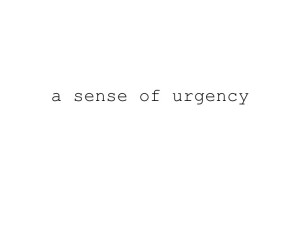
How persuasive are you?
Persuasiveness is the power to induce the taking of a course of action or the embracing of a point of view by means of argument or entreaty.
One of the mistakes salespeople make when doing sales presentations is their tendency to be more informative than persuasive. That difference is costing companies millions of dollars a year in lost sales opportunities. The reason for this is simple. It’s far easier to dispense information than it is to interact with an audience (buyers, stakeholders, etc.) and try and persuade someone to make a commitment to our offer. As a result many sales professionals linger in the information zone citing features and benefits, facts and figures, and delay or even avoid getting into the persuasive zone.
The difference between the two types of presentations is fairly obvious.
 An informative presentation is designed to inform, to be objective while promoting understanding and fostering co-operation.
An informative presentation is designed to inform, to be objective while promoting understanding and fostering co-operation.
A persuasive presentation is about convincing someone to do something i.e. take a new or different course of action; make a commitment to buy our recommended solution; see things from a different point of view that then furthers their willingness to work with us, and so on.
Effective persuasive presenters are much like lawyers who must convince a jury to rule in their client’s favour. If salespeople thought of their presentation as a courtroom case, where they are presenting arguments for their case rather than features and benefits, they would find a greater balance between persuasion and information in their presentations.
At Barrett we regularly run interactive workshops with our clients’ sales teams where their salespeople learn to make persuasive presentations that are designed to positively influence the client showing the buyer how the salesperson’s solutions will really support/help/address the achievement of the client’s goals/ objectives, etc. In addition, we teach salespeople how to make persuasive presentations that are about a fair exchange of value, favouring both the client and the salesperson/organization.
Here are five characteristics of a persuasive presentation:
- Be Interactive:
There must be give and take between presenter and listener. Salespeople should learn to ask questions, listen to the answers and adapt their presentation accordingly. Highly scripted presentations, that don’t have “wiggle room” for interaction with the audience, are often stilted lectures, not persuasive sales presentations.
- Be Convincing:
Being convincing is all about being logical. This process often helps make presentations logical and persuasive:- Generate awareness
- State the problem
- Provide a solution
- Let the buyer visualise change
- Call the buyer to action
 Highlight the priority need:
Highlight the priority need:
Salespeople should develop a sense of urgency to stimulate action. When making a presentation to prospective clients they should be able to see that their failure to act is costing them money, time, effort, lost opportunity, etc. Creating awareness of the priority need(s) isn’t enough. Effective persuasive presentations need to highlight the cost of not getting the priority need(s) addressed. When that happens, prospective buyers start paying more attention to the presentation and how it will affect them personally, professionally, etc.
- Use Risk to Highlight Choice:
Business-to-business buying is about executives looking for ways to make their organisations more effective, more efficient and to minimise the risks the company faces. By highlighting the risk of not taking action in a presentation, salespeople automatically create choice. When buyers understand that the presenter is not only focusing on pushing a point of view, but rather offering to solve business problems by offering choice, prospective buyers become more involved in the presentation and start buying, and that enhances the power of the persuasive nature of sales presentations.
- Be Competitive:
Every decision-maker has four options when considering the purchase. They could decide to accept the salesperson’s offer, decide to go with a rival, consider developing their own solution, or simply doing nothing. Persuasive presentations start with good background research, so that when laying out the alternatives, the presenter can acknowledge the options the prospective client has. Ideally, this would be addressed head-on by showing how the salesperson’s option is the best choice. To be persuasive, simply lay out the facts without denouncing the competition or creating an undue sense of duress for any of the other decisions.
Remember everybody lives by selling something.
Author: Sue Barrett, www.barrett.com.au
Sue Barrett is the founder and CEO of the innovative and forward thinking sales advisory and education firm, Barrett and the online sales education & resource platform www.salesessentials.com. Sue was the first in Australia to get Selling a university qualification and has written more than 600 blog posts and 21 e-books on sales and with her team produces the ‘must read’ Annual 12 Sales Trends Report. Striving to help people and businesses sell better, Sue is a Sales Philosopher, Activist, Strategist, Speaker, Trainer and Adviser. Get to know her further on Twitter, Facebook, and Youtube.
If you valued this article, please hit the ‘like’ button and also share via your Twitter, LinkedIn, Google+ and Facebook social media platforms. You are welcome to join the conversation or ask questions so feel free to add a comment on this post.


New Article Email Notification